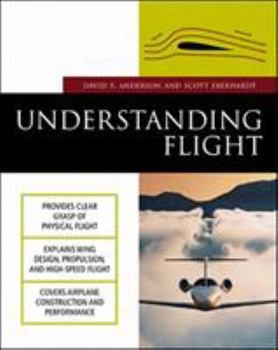Understanding Flight
Select Format
Select Condition 
Book Overview
Publisher's Note: Products purchased from Third Party sellers are not guaranteed by the publisher for quality, authenticity, or access to any online entitlements included with the product. Discover... This description may be from another edition of this product.
Format:Paperback
Language:English
ISBN:0071363777
ISBN13:9780071363778
Release Date:December 2000
Publisher:McGraw-Hill Professional
Length:320 Pages
Weight:1.20 lbs.
Dimensions:9.1" x 0.6" x 7.3"
Customer Reviews
5 ratings
Smartly written
Published by Thriftbooks.com User , 20 years ago
As a pilot, I have more than a passing interest in aerodynamics. If I'm to believe the pundits, it keeps my aircraft up in the air; so out of a feeling of self-preservation, I've tried hard to understand what's happening to my aircraft during flight and as a result and most important, understand what is safe to do during flight. There are many books on the subject with most of them written in dry, academic tones complete with differential calculus. There are notable exceptions to this ('The Science of Flight' by Hubin comes to mind) but really, I've not found many books that take a conversational approach until I got 'Understanding Flight' by Anderson. Quickly but precisely, Anderson dissects aerodynamics for the non-mathematician and using examples from other fields and everyday occurrences, explains what happens when a wing is subject to an airflow. Due to this book, I've been finally disabused of the great sucking theorem by Bernoulli that most often is used to explain lift. The point is, Anderson explains exactly what happens and it makes sense. Along the way, he does a reasonable job of debunking other theories of flight and why they couldn't logically explain heavier-than-air flight. I really like this book and do highly recommend it.
Gets the Job Done
Published by Thriftbooks.com User , 24 years ago
The authors want to give you "the SIMPLEST way to master an understanding of the science of flight". They do this without any real math to speak of, but their text, illustrations, and pictures very well convey the physical description of lift and other material that they strive to present to the reader. A good book for the layman, the beginning and/or more experienced pilot, but too basic for the engineer. There are typos that may confuse (as on page 24), but for the most part the authors have delivered on what you're looking for when you purchase the book.
Understanding Flight
Published by Thriftbooks.com User , 24 years ago
I teach aerodynamics at San Jacinto College in Houston and have been searching for a number of years for what I consider to be satisfactory textbook. "Understanding Flight" meets a college level criteria for the explanation of aerodynamic theories and concepts without the complicated math and geometry. The authors, David Anderson and Scott Eberhardt, have published some interesting papers over the net in the past. I was excited when I found that a book covering all phases of aerodynamics had been produced by the two. A new and refreshing approach to old subjects and misunderstood opinions filled the pages. I have read everything I could find in order to give my students the latest information available. These concepts and the methods used to explain them have not been addressed in a complete textbook up until now, at least to my knowledge. The fact that a physicist and a professor of aeronautics have delivered these principals and ideas in a texbook format lends a tremendous amount of credibility to their validity. I'm thrilled to be able to present these explanations in the classroom but every aviator should possess the understanding this book provides about what's going on about him or her each time they leave the ground.
A Must-Read For everyone interested in machines that fly
Published by Thriftbooks.com User , 24 years ago
. Both authors are scientists and pilots and have teamed up to scientifically challenge some of our traditional explanations of flight found in ground school texts and popular books on airplanes and flying. In fact, the authors point out (and prove) some of the traditional explanations of the physics of flight are just plain wrong. Together these co-authors present an impressive combination of knowledge about airflows, physics, aeronautics, and piloting.The authors make the argument that the airplane wing produces lift because it is literally reacting upward in response to the huge amounts of air being drawn across the top and diverted down behind the trailing edge of a wing. A must-read for every pilot is the book's description of the physics of flowing air bending around the a curved wing surface. We learn that it is the Coanda Effect, viscosity, and boundary layer that keep the air bent over the curvature of the wing. And without these phenomena flight is not possible. These explanations will lead us to answering such intriguing questions as how vortex generators work, why we can't hose the dust off our car, why golf balls are dimpled, why frost on airplane wings is a problem, and how baseball pitchers throw a curve ball.This book should become a standard reference for pilot training.
The title of this book should have been "Wings Illustrated"
Published by Thriftbooks.com User , 24 years ago
This book provides an excellent, non-technical introduction to the flight of airplanes and even golf balls and baseballs. As a beautiful book, it is well-illustrated with good drawings and photographs that help the reader to understand the concepts as they are presented. The side notes on aviation history and facts add interest to the book and should, along with the main text, provide starting points for "coffee table" conversation. The book should even serve to help people who have an irrational fear of commercial aviation to overcome those concerns. I liked the book so much that I am buying three more copies for relatives.






